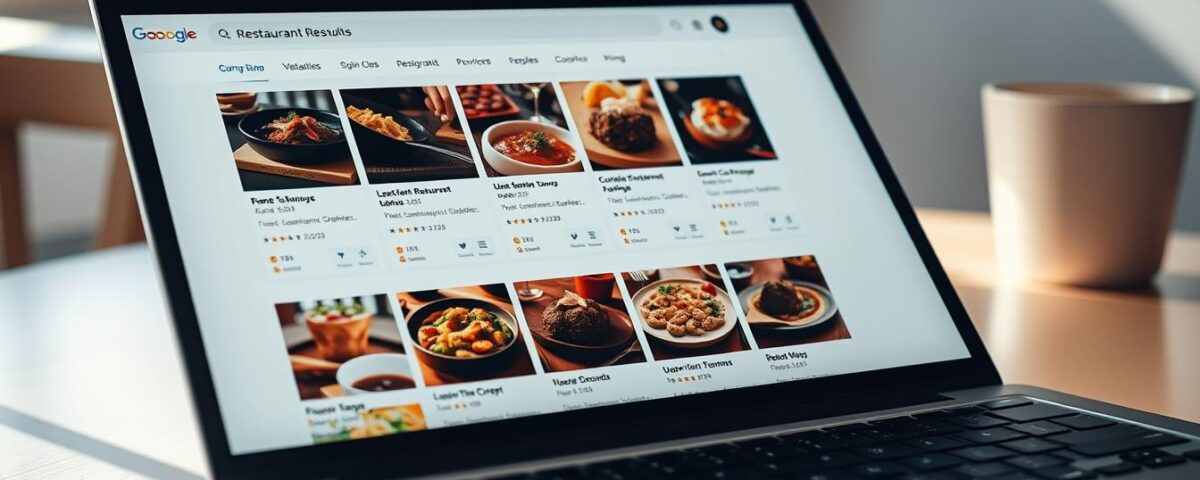
How to Rank Your Restaurant #1 on Google: The Complete Guide
July 7, 2025
Step-by-Step Guide to Getting Your Restaurant on the First Page of Google
July 8, 2025Imagine being the go-to restaurant in town, with a line of customers out the door, all because your online presence is irresistible. With 62% of consumers using Google to research restaurants, your visibility in search results could be the key to your business’s success.
A strong online presence is no longer a luxury, it’s a necessity. By optimizing your website and Google Business Profile, you can increase your visibility in search engines and attract more customers.
So, are you ready to take your restaurant to the top of search results and start serving up more customers than ever before?
Key Takeaways
- Transform your restaurant’s online presence with proven local SEO strategies.
- Discover actionable steps to outrank competitors and attract more customers.
- Learn why a strong local SEO strategy is essential for restaurants.
- Break down complex SEO concepts into simple, implementable tactics.
- Get a clear roadmap to improve your restaurant’s visibility in search engines.
Why Local SEO Is Critical for Your Restaurant’s Success
With the majority of diners turning to online search to find their next meal, a well-optimized local SEO strategy is essential for restaurants to stay ahead. In today’s competitive dining landscape, being visible online is crucial for attracting new customers and driving sales.
Understanding the Restaurant Search Landscape
The way people search for restaurants has changed dramatically. Most consumers now use online search to find dining options, making it vital for businesses to have a strong online presence. A key aspect of this is appearing in Google’s map pack, also known as the local pack, which captures the majority of clicks for local searches.
The Real Benefits of Local SEO for Restaurants
Local SEO offers numerous benefits for restaurants, including increased online visibility, cost-effective marketing, and availability after hours. By optimizing your website and online listings for local search, you can attract more customers and drive sales. Here are some key advantages:
- Increased visibility in search results, leading to more website traffic and phone calls
- Cost-effective marketing with minimal ongoing costs
- Availability after hours, allowing customers to find and learn about your restaurant at any time
| Benefits of Local SEO | Description |
|---|---|
| Increased Online Visibility | Attract more customers through improved search rankings |
| Cost-Effective Marketing | Minimal ongoing costs compared to traditional marketing |
| Availability After Hours | Customers can find your restaurant 24/7 |
By leveraging local SEO, restaurants can improve their online presence, attract more customers, and ultimately drive more sales. As the dining landscape continues to evolve, a well-optimized SEO strategy is crucial for long-term success.
Identifying Your Target Customers Before Starting SEO
Understanding your target audience is the foundation of a successful SEO strategy for restaurants. To optimize your online presence effectively, you need to know who your customers are, what they’re looking for, and how they interact with your website.
Creating Customer Personas for Your Restaurant
Creating detailed customer personas is a crucial step in understanding your target audience. A customer persona is a semi-fictional representation of your ideal customer based on data and research. To create effective personas, consider demographics, preferences, and behaviors of your customers. For example, you might identify a persona as a busy professional looking for quick dinner options or a family seeking kid-friendly restaurants.
Using Analytics Tools to Understand Your Audience
Analytics tools provide valuable insights into your website visitors’ demographics, interests, and online behavior patterns. Tools like Google Analytics and Semrush’s One2Target help you understand who your target customers are and how they find your website. For instance, you can use Semrush’s One2Target to analyze competitors’ domains and gain detailed insights about your target customers’ demographics, including household size, income level, employment status, and education level.
By leveraging these analytics tools, you can refine your customer personas and tailor your SEO strategy to effectively target your audience. This data-driven approach ensures that your SEO efforts are focused on the right customers, improving your online visibility and driving more relevant traffic to your website.
Mastering Local SEO for Restaurants: Keyword Strategy
A well-crafted keyword strategy is the backbone of any successful local SEO campaign for restaurants. To improve your restaurant’s visibility in search results, it’s crucial to understand and implement the right keywords across your digital presence.
Finding the Right Local Keywords for Your Restaurant
Identifying the right keywords for your restaurant involves understanding what your potential customers are searching for. This includes terms related to your cuisine, location, and the services you offer. For instance, if you run a pizza restaurant in New York, relevant keywords might include “New York pizza” or “best pizza in NYC.” Using keyword research tools can help you discover popular search terms and phrases that can be targeted to attract more customers to your restaurant.
It’s also important to consider long-tail keywords that are more specific and less competitive. For example, “gluten-free Italian restaurant in Manhattan” is a long-tail keyword that targets a specific audience. By incorporating these keywords into your website content and other digital platforms, you can improve your search engine rankings and attract more targeted traffic to your restaurant.
Implementing Keywords Across Your Digital Presence
Once you’ve identified your target keywords, it’s essential to implement them strategically across your digital presence. This includes your restaurant’s website, Google Business Profile, social media profiles, and online ordering system. For your website, incorporate keywords into your page URLs, title tags, meta descriptions, headings, and body content. Ensure that your menu pages are optimized with relevant keywords while maintaining an appealing presentation.

Your Google Business Profile is another critical area to implement local keywords, improving your visibility in local search results and Google Maps. Additionally, weave keywords naturally into your social media profiles and posts to create a consistent signal across all platforms. By doing so, you’ll enhance your restaurant’s online presence and improve your local SEO.
Google Business Profile: Your Restaurant’s Digital Storefront
Google Business Profile is a powerful tool that can help your restaurant stand out in search results. By claiming and optimizing your listing, you can provide potential customers with essential information about your business, such as your address, phone number, and hours of operation.
Setting Up and Optimizing Your GBP Listing
To get started, you’ll need to set up and optimize your Google Business Profile listing. This involves providing accurate and up-to-date information about your restaurant, including your business name, address, and category. It’s also crucial to incorporate relevant keywords in your business description to improve your visibility in search results.
When optimizing your GBP listing, make sure to use high-quality images that showcase your restaurant’s interior, exterior, food, and drinks. This will help potential customers get a better sense of what your business has to offer.
Leveraging GBP Features to Attract More Diners
Once your GBP listing is set up and optimized, you can leverage various features to attract more diners to your restaurant. One effective way to do this is by using Google Business Profile posts to share updates, offers, and events with potential customers. You can also use these posts to share photos and add calls to action, such as an “order online” button.
Other features you can utilize include the Q&A section, where you can proactively answer common questions about your restaurant, and the booking button feature, which allows customers to make reservations directly through your GBP listing. By taking advantage of these features, you can enhance your customers’ experience and drive more sales.
Building a Restaurant Website That Converts and Ranks
In today’s digital age, having a restaurant website that is both functional and SEO-friendly is no longer a luxury, but a necessity. A well-designed website is crucial for providing a good user experience, which in turn, improves search engine rankings.
Essential Elements of an SEO-Friendly Restaurant Website
An SEO-friendly restaurant website should have several essential elements. First, it should have a clear and concise navigation menu that allows users to find what they’re looking for quickly. The website should also have a responsive design that adapts to different screen sizes and devices.
High-quality images of your dishes and restaurant ambiance can also enhance the user experience and make your website more engaging. Moreover, your website should have a fast loading speed to reduce bounce rates and improve search engine rankings.
Mobile Optimization and Core Web Vitals
With the majority of diners searching for restaurants on their mobile devices, having a mobile-optimized website is no longer optional. Your restaurant website should have a responsive design that looks great on both desktop and mobile devices.
Google’s Core Web Vitals are also crucial for improving user experience and search engine rankings. These metrics measure page speed, interactivity, and visual stability. By optimizing your website for Core Web Vitals, you can improve your website’s loading speed, reduce bounce rates, and increase the time visitors spend on your site.
Online Reviews: The Secret Ingredient to Local SEO Success
The power of online reviews in boosting a restaurant’s local SEO cannot be overstated. Online reviews significantly impact how your restaurant is perceived by potential customers and search engines alike.
Strategies to Generate More Positive Reviews
To generate more positive reviews, focus on delivering exceptional customer experiences. Train your staff to provide outstanding service, and ensure that your dishes consistently meet high standards. Encourage satisfied customers to leave reviews by displaying visible reminders at your restaurant or through follow-up emails. Utilize review management tools to streamline the process and monitor your online reputation effectively.
Another effective strategy is to engage with your customers on social media platforms, fostering a community around your restaurant. By doing so, you not only encourage feedback but also create a loyal customer base that is more likely to share their positive experiences online.
Effectively Managing and Responding to Customer Feedback
Responding to customer feedback, both positive and negative, is crucial. It shows that you value your customers’ opinions and are committed to their satisfaction. To efficiently manage reviews, use the Review Management feature within the Listing Management tool. Filter by “Not replied” to address unanswered reviews promptly, reinforcing your commitment to customer service.
When responding, be personalized and thoughtful. For positive reviews, express gratitude and highlight your restaurant’s values. For negative feedback, apologize and offer solutions, demonstrating your dedication to improving customer experiences. This approach not only enhances your restaurant’s reputation but also contributes to better local search rankings.
Beyond Your Website: Citations, Directories, and Local Listings
To maximize your restaurant’s online presence, it’s crucial to expand beyond your website and into various directories and listings. This not only enhances your visibility in search results but also provides potential customers with multiple pathways to discover your business.
Building Consistent NAP Citations Across the Web
Consistency is key when it comes to your restaurant’s Name, Address, and Phone Number (NAP) across the web. Inconsistent NAP citations can confuse search engines and negatively impact your local SEO. An easy way to ensure consistency is to use a Listing Management tool. This tool lets you manage and align your NAP data in one place, ensuring accuracy and saving time.
By entering your restaurant’s name and choosing the business with the correct address from the list, you’ll see a report detailing listings with issues, your average star rating, and your total number of reviews. With a paid subscription, the tool can automatically distribute your business information to dozens of directories, ensuring that your NAP data is accurate and up-to-date across the web.
Restaurant-Specific Directories You Can’t Ignore
Certain directories are crucial for restaurants looking to maximize their local SEO potential. These include industry-specific platforms like OpenTable, TripAdvisor, Yelp, and Zomato. Being listed on these directories not only improves your visibility but also allows you to leverage their unique features, such as menu integration and reservation systems.
For instance, OpenTable allows customers to make reservations directly through your listing, while TripAdvisor offers a platform for customers to leave reviews and ratings.

Optimizing your listings on these platforms with complete and accurate information tailored to their specific features and audience is crucial. By prioritizing your efforts across different directories based on their SEO value and relevance to your target customer base, you can create multiple pathways for customers to discover your restaurant.
Conclusion: Measuring Success and Staying Ahead in Restaurant SEO
As we’ve explored throughout this guide, a well-executed local SEO strategy is crucial for your restaurant’s success in today’s digital landscape. To measure the effectiveness of your efforts, it’s essential to track key metrics beyond just search rankings, including website traffic, conversion rates, and actual business impact.
Utilizing tools like Google Analytics and Google Search Console, you can monitor your progress and identify areas for improvement. By analyzing this data, you’ll be able to refine your SEO strategy and stay ahead of algorithm changes and industry trends that could impact your restaurant’s visibility in local search results.
To maintain and build upon your local SEO success, it’s crucial to integrate your efforts with your broader marketing strategy, including social media, email marketing, and in-restaurant promotions. By doing so, you’ll create a cohesive and effective approach to attracting new customers and driving business growth. Remember, SEO is an ongoing process that requires consistent attention and adaptation, not a one-time project that can be completed and forgotten.
By continuously refining your strategy and staying informed about the latest developments in SEO and digital marketing, you’ll ensure your restaurant remains competitive and continues to attract new customers through search for years to come.
FAQ
How can I improve my restaurant’s online visibility?
To boost your restaurant’s online presence, I recommend optimizing your Google Business Profile, creating a user-friendly website, and leveraging social media to engage with customers. By doing so, you’ll increase your chances of appearing in search results and attracting more diners.
What are the most important keywords to target for my restaurant’s website?
When it comes to keywords, I suggest focusing on terms related to your cuisine, location, and menu offerings. For example, if you’re a pizzeria in New York, targeting keywords like “New York pizza” or “best pizza in NYC” can help you attract relevant search traffic.
How do online reviews impact my restaurant’s search engine rankings?
Online reviews play a significant role in determining your restaurant’s search engine rankings. Positive reviews can improve your visibility, while negative reviews can harm it. I recommend encouraging satisfied customers to leave reviews and responding promptly to any negative feedback.
Can I optimize my restaurant’s website for mobile devices?
With most customers using their mobile devices to search for restaurants, having a mobile-friendly website is crucial. I advise ensuring your website is responsive, has fast loading speeds, and provides a seamless user experience across various devices.
How can I measure the success of my restaurant’s SEO efforts?
To gauge the effectiveness of your SEO strategy, I suggest tracking key metrics such as website traffic, search engine rankings, and online engagement. By monitoring these metrics, you’ll be able to refine your approach and make data-driven decisions to improve your online presence.
What is the importance of consistency in my restaurant’s online presence?
Consistency is vital when it comes to your restaurant’s online presence. I recommend ensuring your business name, address, and phone number (NAP) are consistent across the web, including on your website, social media, and online directories.



